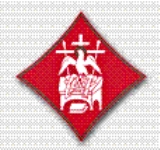
Finnish Orthodox Church
Encyclopedia
The Finnish Orthodox Church is an autonomous Orthodox
Eastern Orthodox Church
The Orthodox Church, officially called the Orthodox Catholic Church and commonly referred to as the Eastern Orthodox Church, is the second largest Christian denomination in the world, with an estimated 300 million adherents mainly in the countries of Belarus, Bulgaria, Cyprus, Georgia, Greece,...
archdiocese of the Patriarchate of Constantinople. The Church has a legal position as a national church in the country, along with the Evangelical Lutheran Church of Finland
Evangelical Lutheran Church of Finland
The Evangelical Lutheran Church of Finland is the national church of Finland. The church professes the Lutheran branch of Christianity, and is a member of the Porvoo Communion....
.
With its roots in the medieval Novgorodian missionary work in Karelia
Karelia
Karelia , the land of the Karelian peoples, is an area in Northern Europe of historical significance for Finland, Russia, and Sweden...
, the Finnish Orthodox Church was a part of the Russian Orthodox Church
Russian Orthodox Church
The Russian Orthodox Church or, alternatively, the Moscow Patriarchate The ROC is often said to be the largest of the Eastern Orthodox churches in the world; including all the autocephalous churches under its umbrella, its adherents number over 150 million worldwide—about half of the 300 million...
until 1923. Today the church has three dioceses and 58,000 members that account for 1.1 percent of the population of Finland
Finland
Finland , officially the Republic of Finland, is a Nordic country situated in the Fennoscandian region of Northern Europe. It is bordered by Sweden in the west, Norway in the north and Russia in the east, while Estonia lies to its south across the Gulf of Finland.Around 5.4 million people reside...
. The parish of Helsinki
Helsinki
Helsinki is the capital and largest city in Finland. It is in the region of Uusimaa, located in southern Finland, on the shore of the Gulf of Finland, an arm of the Baltic Sea. The population of the city of Helsinki is , making it by far the most populous municipality in Finland. Helsinki is...
has the most adherents.
Structure and organization

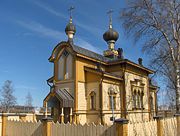
Diocese
A diocese is the district or see under the supervision of a bishop. It is divided into parishes.An archdiocese is more significant than a diocese. An archdiocese is presided over by an archbishop whose see may have or had importance due to size or historical significance...
s (hiippakunta), each with a subdivision of parish
Parish
A parish is a territorial unit historically under the pastoral care and clerical jurisdiction of one parish priest, who might be assisted in his pastoral duties by a curate or curates - also priests but not the parish priest - from a more or less central parish church with its associated organization...
es (seurakunta). There are 24 parishes with 140 priests and more than 58,000 members in total. The number of church members has been steadily growing for several years. A convent and a monastery also operate within the church.
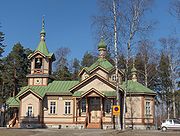
- bishops and coadjutor bishops,
- eleven priests
- three cantors
- eighteen laymen and -women
The priests and cantors elect their representatives on diocesan basis, using plurality election method. The laymen representatives are elected indirectly. The nominations for representatives are made by the parish councils which also elect the electors who then elect the lay representatives to the central synod. The central synod elects the bishops and is responsible for the economy and the general doctrine of the church.
The two executive bodies of the church central administration are the synod of bishops, responsible for the doctrinal and foreign affairs of the church, and the church administrative council (kirkollishallitus), responsible for day-to-day management of the church.
The parishes are governed by the rector and the parish council, which is elected in a secret election. All full-age members of the parish are eligible to vote and to be elected to the parish council. The members of the parish have the right to refrain from being elected to a position of trust of the parish only if they are over 60 years of age, or have served at least eight years in a position of trust. The parish council elects the parish board, which is responsible for the day to day affairs of the parish.
Financially, the church is independent of the state budget. The parishes are financed by the taxes paid by their members. The central administration is financed through the contributions of the parishes. The central synod decides yearly the amount of contributions the parishes are required to make.
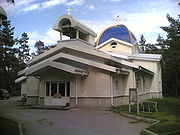
The Finnish law protects the absolute priest-penitent privilege
Priest-penitent privilege
The priest–penitent privilege, also known as the clergy privilege, clergy–penitent privilege, confessional privilege, and ecclesiastical privilege, is an application of the principle of privileged communication that protects the contents of communications between a member of the clergy and a...
. A bishop, priest or diacon of the Church may not divulge information he has heard during confession or spiritual care. The identity of the sinner may not be revealed for any purpose. However, if the priest hears about a crime that is about to be committed, he is responsible for informing the authorities in such manner that the Seal of the Confessional
Seal of the Confessional
In the Roman Catholic Church, the Seal of Confession is the absolute duty of priests not to disclose anything that they learn from penitents during the course of the Sacrament of Penance.-History:...
is not endangered.
Dioceses and bishops
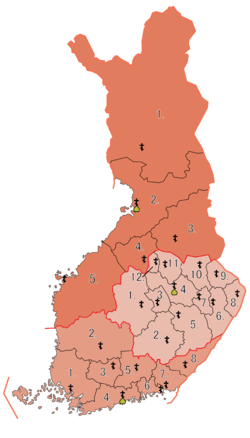
Diocese of Karelia
The seat of the Archbishop of Karelia and All Finland is in KuopioKuopio
Kuopio is a city and a municipality located in the region of Northern Savonia, Finland. A population of makes it the ninth biggest city in the country. The city has a total area of , of which is water and half forest...
. The archbishop is the head of the church and the diocese. He is assisted in the diocese by a suffragan bishop known as the Bishop of Joensuu
Joensuu
Joensuu is a city and municipality in North Karelia in eastern Finland. It is located in the province of Eastern Finland and is part of North Karelia region. It was founded in 1848...
. Despite his title, the bishop is also seated at Kuopio. The word "Karelia" in the archbishop's title only refers to the Finnish Karelia.
The current Archbishop Leo
Leo (Makkonen) of Finland
Archbishop Leo of Karelia and All Finland, head of the Finnish Orthodox Church, was born in Pielavesi in eastern Finland on June 4, 1948. After completing studies in 1972 at the Kuopio seminary, he was ordained deacon on 20 July 1973 and priest two days later.He was consecrated Bishop of Joensuu...
was born in 1948. Before his appointment as the archbishop in 2001, he was the Metropolitan of Oulu. The current Bishop of Joensuu is Arseni, who took the position in 2005.
The Diocese of Karelia has 22,000 church members in 11 parishes. The number of priests in the diocese is about 45, and churches and chapels total over 80. The diocese also includes the only orthodox monasteries in Finland.
The Orthodox Church Museum of Finland also operates in Kuopio.
Diocese of Helsinki

Helsinki
Helsinki is the capital and largest city in Finland. It is in the region of Uusimaa, located in southern Finland, on the shore of the Gulf of Finland, an arm of the Baltic Sea. The population of the city of Helsinki is , making it by far the most populous municipality in Finland. Helsinki is...
has the most members, over 28,000. The diocese is divided into eight parishes, with 50 priests. The main church of the diocese is the Uspenski Cathedral
Uspenski Cathedral
Uspenski Cathedral is an Eastern Orthodox cathedral in Helsinki, Finland, dedicated to the Dormition of the Theotokos . Its name comes from the Old Church Slavonic word uspenie, which denotes the Dormition...
in Helsinki. Characteristic to the diocese is the large number of members who have recently immigrated to Finland, especially in the Helsinki parish where several churches also officiate at the service in foreign languages, including Russian, English, Greek and Romanian.
The current bishop is the Metropolitan Ambrosius. He was appointed in 1988.
Diocese of Oulu
The small Diocese of OuluOulu
Oulu is a city and municipality of inhabitants in the region of Northern Ostrobothnia, in Finland. It is the most populous city in Northern Finland and the sixth most populous city in the country. It is one of the northernmost larger cities in the world....
has only five parishes, the largest of which is Oulu. Traditionally, the Skolt Sami
Skolt Sami
Skolt Sami is a Uralic, Sami language spoken by approximately 400 speakers in Finland, mainly in Sevettijärvi, and approximately 20–30 speakers of the Njuõˊttjäuˊrr dialect in an area surrounding Lake Lovozero in Russia. Skolt Sami used to also be spoken on the Neiden area of Norway,...
people, now a small minority of only 400 speakers, have been the earliest Orthodox Christians in the Finnish Lapland. Today, they live predominantly in the Inari
Inari, Finland
Inari is Finland's largest, sparsely populated municipality with four official languages, more than any other in the country. Its major sources of income are lumber industry and nature maintenance. With the museum Siida in the village of Inari, it is a center of Sami culture...
parish. The diocese was established in 1980. It has fewer than 10,000 members.
The head of the diocese since 1997 has been Metropolitan Panteleimon.
Monasteries

The only Orthodox Christian monastery in Finland, New Valamo Monastery (Valamon luostari), is situated in Heinävesi
Heinävesi
Heinävesi is a municipality of Finland.It is located in the province of Eastern Finland and is part of the Southern Savonia region. The municipality has a population of and covers an area of of which is water...
. The only Orthodox Christian convent Lintula Holy Trinity Convent
Lintula Holy Trinity Convent
Lintula Holy Trinity Convent or Lintula Convent is a small Orthodox Christian convent located in Palokki, Heinävesi, Finland, close to the New Valamo Monastery.-External links:* by the Finnish Orthodox Church...
(Lintulan Pyhän Kolminaisuuden luostari) is in Palokki, some 10 kilometers away from the monastery. Both were established during World War II when residents of the Karelian and Petsamo monasteries were evacuated from areas ceded to the Soviet Union. With friendly support from the Finnish Orthodox Church, a private Orthodox Monastery of Pokrova (Pokrovan veljestö ry) has operated in Kirkkonummi
Kirkkonummi
Kirkkonummi is a municipality of inhabitants in southern Finland. The literal meaning of the words "Kirkkonummi" and "Kyrkslätt" in English is "church moor"....
since 2000, with two permanent members.
Additional organizations
The following organizations operate within or on behalf of the Orthodox Church in Finland:- Fellowship of St. Sergius and St. Herman
- Orthodox Youth Association
- Orthodox Missions
- Orthodox Student Association
- Finnish Association of Orthodox Teachers (Suomen ortodoksisten opettajien liitto ry)
- Orthodox Priests' Association
- Orthodox Cantors' Association
- Finnish Society of Icon Painters (Suomen ikonimaalarit ry)
- Ortaid – Orthodox Church Aid from Finland
Orthodox missions
The Finnish Orthodox Church established its own missionary organization in 1977 known as the Ortodoksinen Lähetys ry (Orthodox Missions). It has mainly been active in eastern Africa.Festivals
The Finnish Orthodox Church celebrates EasterEaster
Easter is the central feast in the Christian liturgical year. According to the Canonical gospels, Jesus rose from the dead on the third day after his crucifixion. His resurrection is celebrated on Easter Day or Easter Sunday...
according to the Gregorian calendar
Gregorian calendar
The Gregorian calendar, also known as the Western calendar, or Christian calendar, is the internationally accepted civil calendar. It was introduced by Pope Gregory XIII, after whom the calendar was named, by a decree signed on 24 February 1582, a papal bull known by its opening words Inter...
, which is uncommon among the Eastern Orthodox jurisdictions. This has met with some disapproval among the Orthodox Churches elsewhere in the world.
Church architecture
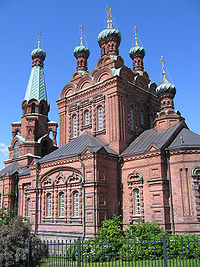



Uspenski Cathedral
Uspenski Cathedral is an Eastern Orthodox cathedral in Helsinki, Finland, dedicated to the Dormition of the Theotokos . Its name comes from the Old Church Slavonic word uspenie, which denotes the Dormition...
(1864) and the Holy Trinity Church (1826). The oldest Orthodox church in Finland is the Virgin Mary Church in Lappeenranta from 1782 - 1785.http://www3.lappeenranta.fi/linnoitus/linnoitusmultimedia/english/rakennukset/ortodoksikirkko.htm
The sympathetic Orthodox Church of St. Peter and St. Paul in Hamina
Hamina
Hamina is a town and a municipality of Finland. It is located in the province of Southern Finland and is part of the Kymenlaakso region. The town has a population of and covers an area of ofwhich is water. The population density is...
was completed in 1837. Built in the architectural style of Neoclassicism
Neoclassicism
Neoclassicism is the name given to Western movements in the decorative and visual arts, literature, theatre, music, and architecture that draw inspiration from the "classical" art and culture of Ancient Greece or Ancient Rome...
with some Byzantine-style elements, the exterior was designed in the form of a round-domed temple, while the interior is cruciform. The belfry was built in 1862 in the Neo-Byzantine
Neo-Byzantine architecture
The Byzantine Revival was an architectural revival movement, most frequently seen in religious, institutional and public buildings. It emerged in 1840s in Western Europe and peaked in the last quarter of 19th century in the Russian Empire; an isolated Neo-Byzantine school was active in Yugoslavia...
style.
The Orthodox church of Tampere
Tampere
Tampere is a city in southern Finland. It is the most populous inland city in any of the Nordic countries. The city has a population of , growing to approximately 300,000 people in the conurbation and over 340,000 in the metropolitan area. Tampere is the third most-populous municipality in...
was built in Russian romantic style, with onion style cupolas, and was ready in 1896. The architect of the Russian army, T.U. Jasikov, drew the floor plan. The church was consecrated in 1899 to Saint Alexander Nevsky
Alexander Nevsky
Alexander Nevsky was the Prince of Novgorod and Grand Prince of Vladimir during some of the most trying times in the city's history. Commonly regarded as the key figure of medieval Rus, Alexander was the grandson of Vsevolod the Big Nest and rose to legendary status on account of his military...
, a Novgorodian who in 1240 fought against the Catholic Swedes and two years later the Catholic Teutonic Knights
Teutonic Knights
The Order of Brothers of the German House of Saint Mary in Jerusalem , commonly the Teutonic Order , is a German medieval military order, in modern times a purely religious Catholic order...
with equal success, and was accordingly canoniced for these nationalistic but bloody deeds. Emperor Nicholas II donated the bells to this church. The church suffered heavily during the Finnish civil war
Finnish Civil War
The Finnish Civil War was a part of the national, political and social turmoil caused by World War I in Europe. The Civil War concerned control and leadership of The Grand Duchy of Finland as it achieved independence from Russia after the October Revolution in Petrograd...
in 1918; its reconstruction took many years. After Finland declared its independence, it was re-consecrated to St. Nicholas, a less belligerent saint.
Construction of new Orthodox churches continues in Finland. One of the latest is the Church of Saint John the Theologian in Pori
Pori
Pori is a city and municipality on the west coast of Finland. The city is located some from the Gulf of Bothnia, on the estuary of the Kokemäenjoki river, which is the largest in Finland. Pori is the most important town in the Satakunta region....
, completed in 2002.
History
Christianity started to spread to Finland from the east in the Orthodox form and from the west in the Catholic form at the latest in the beginning of the 12th century. Some of the earliest excavated crosses in Finland, dating from the 12th century onward, are similar to a type found in Novgorod and KievKiev
Kiev or Kyiv is the capital and the largest city of Ukraine, located in the north central part of the country on the Dnieper River. The population as of the 2001 census was 2,611,300. However, higher numbers have been cited in the press....
. Orthodox parishes are believed to have existed as far to the west as Tavastia
Tavastia (historical province)
Tavastia, Tavastland or Häme, Russian Emi or Yemi, is a historical province in the south of Finland. It borders Finland Proper, Satakunta, Ostrobothnia, Savonia and Uusimaa.- Administration :...
, the area inhabited by Tavastians
Tavastians
Tavastians are a historic people and a modern subgroup of the Finnish people. They live in areas of the historical province of Tavastia and speak Tavastian dialects....
in Central Finland.

Greek language
Greek is an independent branch of the Indo-European family of languages. Native to the southern Balkans, it has the longest documented history of any Indo-European language, spanning 34 centuries of written records. Its writing system has been the Greek alphabet for the majority of its history;...
. These include the words for priest (pappi), cross (risti) and bible (raamattu). This hypothesis is, however, not unchallenged.
Clash between Catholicism and Orthodoxy
In the middle of the 13th century the inevitable clash between the two expanding countries, SwedenSweden
Sweden , officially the Kingdom of Sweden , is a Nordic country on the Scandinavian Peninsula in Northern Europe. Sweden borders with Norway and Finland and is connected to Denmark by a bridge-tunnel across the Öresund....
and Novgorod, and the two forms of Christianity they represented, took place. The final border between western and eastern rulership was drawn in the Peace Treaty of Nöteborg
Treaty of Nöteborg
Treaty of Nöteborg, also known as Treaty of Oreshek , is a conventional name for the peace treaty that was signed at Orekhovets on August 12, 1323. It was the first settlement between Sweden and Novgorod Republic regulating their border...
, in 1323. Karelia was definitely ceded to Novgorod and Orthodoxy.
Karelian monasteries
The main missionary work fell to the monasteries that cropped up in the wilderness of Karelia. Two monasteries were founded on islands in Lake Ladoga
Lake Ladoga
Lake Ladoga is a freshwater lake located in the Republic of Karelia and Leningrad Oblast in northwestern Russia, not far from Saint Petersburg. It is the largest lake in Europe, and the 14th largest lake by area in the world.-Geography:...
, which became some centuries later famous: the monasteries of Valaam
Valaam Monastery
The Valaam Monastery, or Valamo Monastery is a stauropegic Orthodox monastery in Russian Karelia, located on Valaam, the largest island in Lake Ladoga, the largest lake in Europe.-History:...
and Konevsky
Konevsky Monastery
Konevsky Monastery is a Russian Orthodox monastery that occupies Konevets Island in the western part of the Lake Ladoga, Leningrad Oblast, Russian Federation. It is often regarded as the twin monastery with the Valaam Monastery, also located on an island in the same lake.- Medieval origins...
.
Karelian and Finnish forests were also populated by spiritually advanced hermits. Often around the hermit's hut or skete, there settled other fighters of the good fight of faith, and so a new monastery was founded. One of the most important examples of this process was St. Alexander of Svir 1449–1533. He was a Karelian who fought the fight of faith for 13 years in Valaam monastery, but finally left it, and in the end founded a monastery at the river of Svir.
Swedish oppression
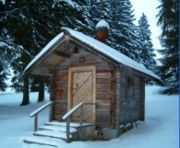
Estonia
Estonia , officially the Republic of Estonia , is a state in the Baltic region of Northern Europe. It is bordered to the north by the Gulf of Finland, to the west by the Baltic Sea, to the south by Latvia , and to the east by Lake Peipsi and the Russian Federation . Across the Baltic Sea lies...
and Latvia
Latvia
Latvia , officially the Republic of Latvia , is a country in the Baltic region of Northern Europe. It is bordered to the north by Estonia , to the south by Lithuania , to the east by the Russian Federation , to the southeast by Belarus and shares maritime borders to the west with Sweden...
to Sweden.
Karelians mostly identified themselves with the Russians, and not with the Finns. Karelians also called the Finns as "ruotsi," which is the Finnish word for Swedes.
The Lutheran state church of Sweden tried to convert the Orthodox population. They were not allowed to fetch priests from Russia, which meant, in the long run, that they did not have priests at all. The universities of Sweden taught only Lutheran theology. Lutheran books were translated into Slavonic, and the population was forced to read them. As Lutheranism was the only legal religion in Sweden, to be an Orthodox was a handicap in many ways. About two-thirds of the orthodox population preferred to flee to Central Russia rather than stay under an oppressive government. They formed the population of Tver Karelia. The Swedish state encouraged Lutheran Finns to occupy the deserted farms in Karelia. This massive flight of Orthodox Finns away from Finland meant that Eastern Orthodoxy was never again the main religion of any part of Finland. However, in the remoter areas of Eastern Finland and Karelia, like Ilomantsi and Taipale, the Eastern Orthodox Christianity survived better.
Reunion with the Russian Orthodox Church
The period of the grandiose expansion of Sweden met its limits in two wars: the Great Northern WarGreat Northern War
The Great Northern War was a conflict in which a coalition led by the Tsardom of Russia successfully contested the supremacy of the Swedish Empire in northern Central Europe and Eastern Europe. The initial leaders of the anti-Swedish alliance were Peter I the Great of Russia, Frederick IV of...
which ended in the Treaty of Nystad
Treaty of Nystad
The Treaty of Nystad was the last peace treaty of the Great Northern War. It was concluded between the Tsardom of Russia and Swedish Empire on 30 August / 10 September 1721 in the then Swedish town of Nystad , after Sweden had settled with the other parties in Stockholm and Frederiksborg.During...
in 1721 and the Hat's War
Russo-Swedish War
Russo-Swedish Wars may refer to:* Swedish–Novgorodian Wars, a series of conflicts in the 12th and 13th centuries* Russo-Swedish War , result of an alliance between Ivan III of Russia and Hans of Denmark...
(1741–43) with the Treaty of Turku in 1743. Sweden lost all its provinces in the Baltic region
Baltic region
The terms Baltic region, Baltic Rim countries, and Baltic Rim refer to slightly different combinations of countries in the general area surrounding the Baltic Sea.- Etymology :...
, and a portion of eastern Finland to Russia.
The Valaam Monastery
Valaam Monastery
The Valaam Monastery, or Valamo Monastery is a stauropegic Orthodox monastery in Russian Karelia, located on Valaam, the largest island in Lake Ladoga, the largest lake in Europe.-History:...
was re-established in Lake Ladoga, and a new main church was consecrated in 1719. Monks returned to Konevsky Monastery
Konevsky Monastery
Konevsky Monastery is a Russian Orthodox monastery that occupies Konevets Island in the western part of the Lake Ladoga, Leningrad Oblast, Russian Federation. It is often regarded as the twin monastery with the Valaam Monastery, also located on an island in the same lake.- Medieval origins...
before 1716. The Russian government naturally favoured the activities of the religion they had professed for many centuries. The Emperors and Empresses paid for the reconstruction of burnt or otherwise demolished churches. As pilgrimage is considered a very important activity for the faithful, the Orthodox population of Eastern Finland again had access to making pilgrimages to the monasteries of Solovetsk
Solovetsky Monastery
Solovetsky Monastery was the greatest citadel of Christianity in the Russian North before being turned into a special Soviet prison and labor camp , which served as a prototype for the GULag system. Situated on the Solovetsky Islands in the White Sea, the monastery braved many changes of fortune...
and Alexander-Svirsky
Alexander-Svirsky Monastery
Alexander-Svirsky Monastery is a Russian Orthodox monastery situated deep in the woods of the Leningrad Oblast, just south from its border with the Republic of Karelia...
.
The Old Believers
Old Believers
In the context of Russian Orthodox church history, the Old Believers separated after 1666 from the official Russian Orthodox Church as a protest against church reforms introduced by Patriarch Nikon between 1652–66...
, a schismatic group of Russians who did not accept the religious reforms of patriarch Nikon
Patriarch Nikon
Nikon , born Nikita Minin , was the seventh patriarch of the Russian Orthodox Church...
in 1666–67, were excommunicated from the Orthodox Church and fled to the outskirts of Russia. They also moved into the remote areas of Finland building three small monasteries there. However, the activity of these monasteries stopped during the following century.
Autonomous Grand Duchy of Finland
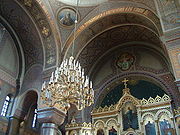
When Russia at the end of the 19th century tried to retract the autonomy of Finland, the Lutheran Finns started to associate the Orthodox Church with the imperial Russian rule, labeled as the ryssän kirkko. The cultural gap between the two churches remained significant.
In areas where Orthodox faith was not indigenous as in the towns of Helsinki
Helsinki
Helsinki is the capital and largest city in Finland. It is in the region of Uusimaa, located in southern Finland, on the shore of the Gulf of Finland, an arm of the Baltic Sea. The population of the city of Helsinki is , making it by far the most populous municipality in Finland. Helsinki is...
, Tampere
Tampere
Tampere is a city in southern Finland. It is the most populous inland city in any of the Nordic countries. The city has a population of , growing to approximately 300,000 people in the conurbation and over 340,000 in the metropolitan area. Tampere is the third most-populous municipality in...
and Viipuri
Vyborg
Vyborg is a town in Leningrad Oblast, Russia, situated on the Karelian Isthmus near the head of the Bay of Vyborg, to the northwest of St. Petersburg and south from Russia's border with Finland, where the Saimaa Canal enters the Gulf of Finland...
and the Karelian Isthmus
Karelian Isthmus
The Karelian Isthmus is the approximately 45–110 km wide stretch of land, situated between the Gulf of Finland and Lake Ladoga in northwestern Russia, to the north of the River Neva . Its northwestern boundary is the relatively narrow area between the Bay of Vyborg and Lake Ladoga...
, Orthodoxy was especially associated with the Russians, the bulk of whom was made up of Russian troops permanently stationed in Finland. Generally most ecclesiastical activity outside Karelia centered on the garrison churches. There were also a growing number of Russian emigrants, most of whom were merchants or craftsmen. These started to identify themselves with the Swedish-speaking bourgeoisie, and so a Swedish-speaking branch of the Finnish Orthodox Church was born.
The 19th century was also a period of active building of new churches, the Uspenski Cathedral
Uspenski Cathedral
Uspenski Cathedral is an Eastern Orthodox cathedral in Helsinki, Finland, dedicated to the Dormition of the Theotokos . Its name comes from the Old Church Slavonic word uspenie, which denotes the Dormition...
being the most important of them. The garrisons needed Orthodox churches and so did the new emigrants to the towns. A good examples are the Orthodox church of Tampere and Turku.
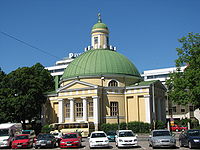
A separate Finnish episcopate with a leading archbishop was established in 1892 under the Russian Orthodox Church. It was stationed in Vyborg
Vyborg
Vyborg is a town in Leningrad Oblast, Russia, situated on the Karelian Isthmus near the head of the Bay of Vyborg, to the northwest of St. Petersburg and south from Russia's border with Finland, where the Saimaa Canal enters the Gulf of Finland...
, with the Russian Antoniy as its first bishop.
Independent Finland
Shortly after Finland declared independence from Russia in 1917, the Finnish Orthodox Church declared its autonomy from the Russian Church. Finland's first constitution (1919) granted the Orthodox Church an equal status with the (Lutheran) Church of Finland.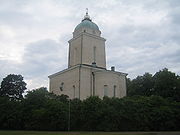
Ecumenical Patriarchate of Constantinople
The Ecumenical Patriarchate of Constantinople , part of the wider Orthodox Church, is one of the fourteen autocephalous churches within the communion of Orthodox Christianity...
. At the same time the Gregorian Calendar
Gregorian calendar
The Gregorian calendar, also known as the Western calendar, or Christian calendar, is the internationally accepted civil calendar. It was introduced by Pope Gregory XIII, after whom the calendar was named, by a decree signed on 24 February 1582, a papal bull known by its opening words Inter...
was adopted. Other reforms introduced after independence include changing the language of the liturgy from Church Slavonic to Finnish and the transfer of the Archiepiscopal seat from Viipuri
Vyborg
Vyborg is a town in Leningrad Oblast, Russia, situated on the Karelian Isthmus near the head of the Bay of Vyborg, to the northwest of St. Petersburg and south from Russia's border with Finland, where the Saimaa Canal enters the Gulf of Finland...
to Sortavala
Sortavala
Sortavala is a town in the Republic of Karelia, Russia, located at the northern tip of Lake Ladoga. Population: It is an important station of the Vyborg-Joensuu railroad.-History:...
.
Until World War II, the majority of the Orthodox Christians in Finland were located in Karelia. As a consequence of the war, residents of the areas ceded to the Soviet Union were evacuated to other parts of the country. The monastery
Monastery
Monastery denotes the building, or complex of buildings, that houses a room reserved for prayer as well as the domestic quarters and workplace of monastics, whether monks or nuns, and whether living in community or alone .Monasteries may vary greatly in size – a small dwelling accommodating only...
of Valamo was evacuated in 1940 and the monastery of New Valamo was founded in 1941 at Heinävesi
Heinävesi
Heinävesi is a municipality of Finland.It is located in the province of Eastern Finland and is part of the Southern Savonia region. The municipality has a population of and covers an area of of which is water...
, on the Finnish side of the new border. Later, the monks from Konevsky and Petsamo
Pechenga Monastery
The Pechenga Monastery was for many centuries the northernmost monastery in the world. It was founded in 1533 at the influx of the Pechenga River into the Barents Sea, 135 km west of modern Murmansk, by St...
monasteries also joined the New Valamo monastery. The nunnery of Lintula (now Ogonki) near Kivennapa (Karelian Isthmus) was also evacuated, and re-established at Heinävesi in 1946.

Kuopio
Kuopio is a city and a municipality located in the region of Northern Savonia, Finland. A population of makes it the ninth biggest city in the country. The city has a total area of , of which is water and half forest...
and the diocesan seat of Viipuri was moved to Helsinki
Helsinki
Helsinki is the capital and largest city in Finland. It is in the region of Uusimaa, located in southern Finland, on the shore of the Gulf of Finland, an arm of the Baltic Sea. The population of the city of Helsinki is , making it by far the most populous municipality in Finland. Helsinki is...
. A third diocese was established in Oulu
Oulu
Oulu is a city and municipality of inhabitants in the region of Northern Ostrobothnia, in Finland. It is the most populous city in Northern Finland and the sixth most populous city in the country. It is one of the northernmost larger cities in the world....
in 1979.
After the Second World War the membership of the Orthodox Church in Finland decreased slowly, as the Karelian evacuees were settled far from their roots among the Lutheran majority of Finland. Mixed marriages became common and the children were often baptized into the religion of the majority. But quite unexpectedly a "romantic" movement arose in Finland beginning in the 1970s onward glorifying Orthodoxy, its "mystical" and visually beautiful services and icons (religious paintings) and its deeper view of Christianity than that of the Lutheran Church. For these reasons, similar to Catholicism in England, conversion to the Orthodox Church became almost a fad, and its membership started to grow.
At the same time Archbishop Paavali of Karelia and All Finland (1960–1987) made liturgical changes to the services, that gave the laymen a more active role in the church services, and made the services more open (earlier the clergy stayed a part of the services behind a curtain) and intelligible. Archbishop Paavali also stressed the importance of partaking in the Eucharist as often as possible.
Russian Orthodox Church in Finland
About 2,000 Orthodox Christians in Finland belong to the Russian Orthodox Church, organized into two parishes. There have also been plans to establish a separate Russian diocese in Finland. Parishes maintain five churches and chapels.St. Nicholas Orthodox Parish (Finnish: Ortodoksinen Pyhän Nikolauksen Seurakunta, Russian: Свято-Никольский приход в Хельсинки) in Helsinki is the largest with 1,500 members of which 70 percent are Finnish citizens. The parish was established in 1927.
Roots in the 1920s' Private Orthodox Society in Vyborg (Finnish: Yksityinen kreikkalais-katolinen yhdyskunta Viipurissa), the Intercession Orthodox Parish (Finnish: Ortodoksinen Pokrovan seurakunta, Russian: приход Покрова Пресвятой Богородицы в Хельсинки) was officially formed in 2004, also in Helsinki, and has some 350 members today. Both have registered themselves as separate religious organizations.
Unlike the Finnish Orthodox Church, the Russian Orthodox Church in Finland follows the Julian calendar
Julian calendar
The Julian calendar began in 45 BC as a reform of the Roman calendar by Julius Caesar. It was chosen after consultation with the astronomer Sosigenes of Alexandria and was probably designed to approximate the tropical year .The Julian calendar has a regular year of 365 days divided into 12 months...
.
List of archbishops
Under Patriarchate of Moscow:- Antoniy (1892–1898)
- Nikolay (1899–1905)
- Sergiy (1905–1917)
- Serafim (1918–1923), Bishop of Finland from 1918 and archbishop from 1921
Under Patriarchate of Constantinople:
- HermanHerman (Aav)Herman was an Estonian Orthodox clergyman who served from 1925 to 1960 as Archbishop of the Finnish Orthodox Church....
(1923–1960) - Paavali ("Paul") (1960–1987)
- Johannes ("John")John RinneJohn Wilho Rinne was the Orthodox Archbishop of Karelia and All Finland from 1987 to 2001.-Birth:Rinne was born in Turku, Finland on 16 August 1923 to a family belonging to the Evangelical Lutheran Church of Finland....
(1987–2001) - LeoLeo (Makkonen) of FinlandArchbishop Leo of Karelia and All Finland, head of the Finnish Orthodox Church, was born in Pielavesi in eastern Finland on June 4, 1948. After completing studies in 1972 at the Kuopio seminary, he was ordained deacon on 20 July 1973 and priest two days later.He was consecrated Bishop of Joensuu...
(2001-)
External links
- The Orthodox Church of Finland (Official site)
- New Valamo Monastery in Finland
- OrtoWeb (Learning Environment for R.E)
- Ortodoksi.net
- Article on Finnish Orthodox Church on the CNEWA website

